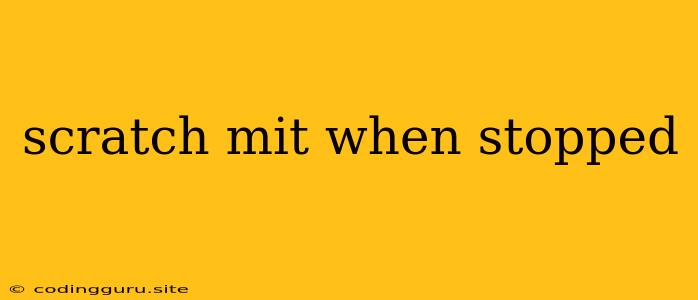Scratch: Understanding and Utilizing the "When Stopped" Block
Scratch, a visual programming language developed by the MIT Media Lab, empowers users to create interactive stories, games, and animations. It's a fantastic tool for learning fundamental programming concepts, and one of its key features is the "When Stopped" block. This block allows you to trigger specific actions or commands once a project stops running.
What is the "When Stopped" Block?
The "When Stopped" block is a special event block in Scratch. It doesn't start a script directly but rather waits for a specific event: the project being stopped. This block acts as a trigger, initiating a set of actions only when the project stops.
Why Use the "When Stopped" Block?
The "When Stopped" block is incredibly useful for a variety of reasons:
- Resetting the Project: You can use this block to reset variables, clear sprites, or return the project to its initial state.
- Final Actions: Some scripts might need to perform a final action after the project stops running. This block ensures these actions are executed at the appropriate time.
- Ending a Game: It can be used to display a game over screen, reset game variables, or even play a sound effect when the game concludes.
- Controlling Loops: The "When Stopped" block can be used to stop a loop, making your project more responsive and efficient.
How to Use the "When Stopped" Block
- Find the Block: Navigate to the "Events" category in the Scratch block palette. The "When Stopped" block appears at the bottom.
- Drag and Drop: Drag and drop the "When Stopped" block onto the scripting area.
- Connect Blocks: Attach other blocks to the "When Stopped" block, forming a script. This script will execute only when the project stops.
Example: Resetting a Variable
Imagine you're creating a game where a player collects points. You want the score to reset to zero every time the game ends. Here's how you can use the "When Stopped" block to achieve this:
- Create a Variable: Create a variable named "Score" to keep track of the player's points.
- Use "When Stopped": Add the "When Stopped" block to your script.
- Set Variable to Zero: Connect the "set [variable] to [value]" block to the "When Stopped" block, setting the "Score" variable to 0.
Code Snippet:
when stopped
set [Score] to [0]
This script will automatically reset the "Score" variable to 0 whenever the project is stopped.
Example: Ending a Game
Consider a game where the player controls a character that needs to collect a certain number of items to win. Here's how you can use the "When Stopped" block to end the game when the player wins:
- Create a Variable: Create a variable named "Items Collected" to keep track of the items.
- Check the Condition: Use a "if [condition] then [script]" block to check if the player has collected the required number of items.
- Stop the Project: Inside the "if" block, add the "stop [this script] block" to halt the project.
- Display Game Over: Connect the "When Stopped" block to a script that displays a "You Win!" message.
Code Snippet:
when green flag clicked
set [Items Collected] to [0]
when this sprite clicks
change [Items Collected] by [1]
if <(Items Collected) = [10]> then
stop [this script]
when stopped
say [You Win!] for (2) secs
This example shows how the "When Stopped" block can be used to create a dynamic game ending.
Conclusion
The "When Stopped" block in Scratch provides a valuable tool for adding functionality and control to your projects. It enables you to perform actions at the end of a project, reset variables, or trigger specific events upon project completion. By mastering the use of this block, you can create more sophisticated and engaging Scratch projects.
